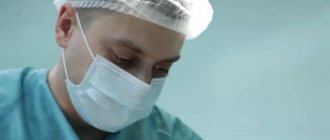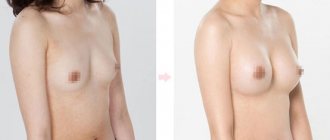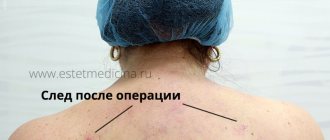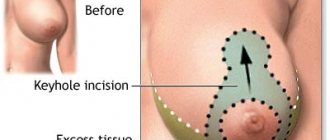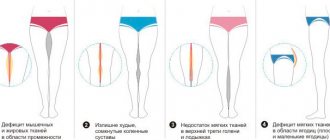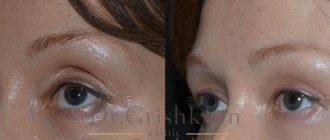Classification of the skin-fat apron
Skin-fat deformation has the appearance of a hanging fold of fat, the severity of which is determined by the plastic surgeon. This cosmetic defect has the following levels of deformation:
- 1st degree - lowering of the fold to the level of the pubis;
- 2nd degree - the fold descends to the organs of the reproductive system;
- 3rd degree - sagging of the fold to the third of the thigh;
- 4th degree - sagging of the fat fold to the middle of the thighs;
- 5th degree - lowering the fold to the level of the knees.
Each level of skin-fat deformation has its own difficulties, characteristics and pain.
Who needs a panniculectomy
One of the indications for panniculectomy is the formation of a skin fold on the abdomen. A fatty apron is not only an aesthetic defect, which greatly damages the nerves of its owner and develops complexes in a person, but also a medical problem. ! The fold is a “heavenly place” for the reproduction and life of bacteria. A fatty apron leads to poor circulation and problems in the intimate area. The causes of skin folds are often associated with sudden changes in weight, for example, during weight loss or pregnancy.
Symptoms of skin-fat deformation
The symptoms of a skin-fat apron are quite specific. When this deformation occurs, a person experiences an unpleasant feeling during sexual intercourse and problems with the genitourinary system. In the first three stages of the skin-fat apron, its symptoms are limited only to an aesthetic problem and discomfort. The fourth and fifth stages are characterized by such signs as the appearance of diaper rash, itching, a feeling of irritation and a sharp unpleasant odor in the folds of skin and fat deformation and pain in the abdominal area.
Indications and contraindications for panniculectomy
The indication for the procedure is the presence of a skin-fat apron. It is important that the patient’s weight is stabilized before the intervention. If further weight loss is planned, the problem may return, and the effect of the operation will disappear.
Panniculectomy is a traumatic and complex operation, so there are many contraindications to it. Intervention is not carried out in the following cases:
- hypertension;
- infectious diseases;
- chronic diseases in the acute stage;
- blood clotting disorder;
- obesity;
- diabetes mellitus and other diseases of the endocrine system;
- oncology;
- autoimmune diseases;
- problems with the cardiovascular system;
- liver and kidney failure;
- any diseases of internal organs.
Diagnosis of the skin-fat apron
If you have the first two degrees of manifestation of skin-fatty deformation, you should seek advice from a dermatologist, therapist, cosmetologist, plastic surgeon and nutritionist. To determine the cause of this defect, the following diagnostic examinations are used:
- physical examinations by specialists;
- passing general clinical tests;
- ultrasound examination of the abdominal cavity;
- carrying out magnetic resonance imaging.
After passing tests and conducting a series of studies, the specialist will study the increase and development of skin-fat deformation, and will also choose the appropriate individual treatment method.
Recovery period
When small areas of skin and fat are removed, patients can be discharged on the same day of surgery. If a large “apron” is removed, the patient will be hospitalized for several days. In some cases, doctors prescribe antibiotic therapy, physical therapy and other procedures to the area of the postoperative wound.
In the first days after panniculectomy, hygiene is carried out using damp sponges. After 2 days, showers are allowed. The bath can be taken only after the wound has completely healed, about a month after the operation.
In the first postoperative week, moderate pain, bruising, and swelling of the skin in the area of the postoperative wound will be natural.
After a week, the superficial sutures are removed. The deeper ones resolve on their own.
Bruising and swelling disappear gradually over 6-12 weeks. You can speed up this process by using lymphatic massage.
Light exercise is indicated after 10-14 days. Any heavy loads, weightlifting, or sports competitions are prohibited for at least 8 weeks.
You can return to work after 3 weeks. Before this, the patient must be examined by a plastic surgeon and ensure that there are no complications. By the end of the month, you can gradually stop using compression bandages.
Full recovery may take several months. It is important that the patient carefully follows all postoperative instructions from the doctor.
A panniculectomy leaves a large horizontal scar. It is usually hidden under underwear. Over the course of 12-18 months, such a scar gradually fades and may disappear. To do this, it is useful to use special creams for resolving scars, such as Fermenkol.
The result of panniculectomy is not only the elimination of the interfering skin apron, but also additional weight loss. It ranges from 2 to 5 kg. Patients note improved personal hygiene and greater ease in performing physical activity.
Panniculectomy is a plastic surgery to remove the so-called “fat apron” on the abdomen. During surgery, excess skin and the fat layer underneath are removed.
It is panniculectomy that is indicated for sagging skin of the anterior abdominal wall, because, for example, liposuction only deals with excess fat. Panniculectomy should also not be confused with abdominoplasty, in which, in addition to excision of skin and fat, the abdominal muscles are tightened. When removing the “fat apron” on the abdomen, these two operations can be combined if there are indications for this.
Plastic correction of the skin-fat apron
Plastic correction of the skin-fat apron involves a surgical operation such as abdominoplasty. Indications for plastic correction of skin-fat deformation will be the presence of varying degrees of prolapse. Before the operation, the patient’s weight must be stable for a year, and exercise and diet therapy are also recommended.
Contraindications to plastic correction of skin-fat deformation include:
- severe obesity;
- pregnancy planning;
- the presence of postoperative scars above the umbilical region;
- decompensated form of diabetes mellitus;
- oncological diseases.
How is panniculectomy performed?
In order for a patient to make an appointment with a surgeon about a panniculectomy, he will first need to lose weight if the person was previously obese. Only if you maintain a constant normal weight throughout the year will it be possible to perform an operation to remove the subcutaneous fat apron. You should start playing sports and other physical activity about two months before surgery. This will strengthen the muscles and allow the body to recover more easily after surgery. When the patient attends a consultation with a surgeon, as a result of which it is decided that an operation is necessary, tests are prescribed: a general blood and urine test, a biochemical blood test, blood for HIV, hepatitis and syphilis, a coagulogram, an ECG and fluorography. If, as a result of specialists studying the research results, no contraindications to panniculectomy are identified, a date for the operation is set. Two weeks before this day, you should completely stop smoking cigarettes and drinking alcohol, taking blood thinners, and taking oral contraceptives. In order to eliminate the negative consequences of the operation, it is worth visiting a consultation with an anesthesiologist to identify the presence of a possible allergy to painkillers.
The patient should purchase compression garments in advance, the size of which will be determined by the surgeon. Usually, when performing surgery on a woman, the doctor tries to set a date for panniculectomy for the first half of the menstrual cycle. During surgery, general anesthesia will be used, so the patient must stop eating 8-12 hours before surgery. On the day of the procedure, the patient arrives at the clinic, where he is invited to take a shower. During the hygiene procedure, hair in the area of the operation should be removed. When preparation is completed, the patient is invited to the room where he is given general anesthesia. After the anesthetic begins to take effect, the abdominal area is disinfected and a vertical incision is made, which starts from the lower area of the sternum and continues all the way to the pubic area. This is followed by a horizontal incision, which is made in the pubic area. Excess fatty tissue and skin are excised; if there are scars after a cesarean section, they are removed. After which the skin flaps are sutured with self-absorbing threads. At the end of the operation, a silicone drainage tube is installed and an aseptic dressing is applied. The patient is also wearing compression garments, which will help reduce swelling.
Methods for removing skin-fat apron
There are various technologies for performing abdominoplasty; before performing them, it is necessary to undergo an extensive medical examination to determine contraindications. The essence of abdominoplasty is to peel away the front part of the peritoneal wall and move it lower, while excess fat and skin are removed. Before suturing the wound, silicone drains are installed to ensure timely drainage of fluid, after which continuous skin sutures are installed in layers.
The following methods for removing skin-fat deformation are distinguished:
- Dermatolipectomy (panniculectomy) is an operation that makes it possible to eliminate excess skin and fat. It consists of dissecting the skin-fat fold in the abdominal area and can be combined with herniotomy and hysterectomy;
- Liposuction is the limited removal of fat through minor punctures using a cannula;
- Local abdominoplasty is an operation in the lower abdomen, which is performed without transferring the navel. This type of abdominoplasty is used to eliminate minor aesthetic defects and stretch marks that appear during pregnancy;
- Extended abdominoplasty is a technology for removing skin and fat deformation, which requires relocation of the navel, which helps to give a natural and harmonious appearance to the abdomen. Extended abdominoplasty is prescribed when the defect reaches a large size and if it is necessary to completely correct the tissues of the abdominal wall;
- Mini abdominoplasty is a surgical intervention that involves cutting excess skin in the anterior peritoneum area and does not involve transferring the navel. In most cases, mini abdominoplasty is combined with liposuction.
Results of panniculectomy
After removal of excess subcutaneous fat and skin in the abdominal area, the patient will need to take painkillers for several days to eliminate pain. The dressings will be changed by the clinic staff, because... After the operation, the patient will remain in the hospital for some time, namely about one week. The rehabilitation period will last up to one month, after which it will be possible to evaluate the first results of the panniculectomy. During this time, the patient must wear compression garments and stop wearing them only after the permission of his surgeon.
Rehabilitation period after removal of the skin-fat apron
After plastic correction of skin-fat deformation, the patient requires a long recovery period. Discharge from the hospital occurs on the second day, but specialists monitor the condition of the patient’s abdominal wall for several weeks. Before the surgical sutures are removed, dressings are performed three times a week. After a few days, the installed drainage system is removed. During the recovery period, it is necessary to wear compression underwear and avoid physical activity. The scar after the operation is quite noticeable, but over time it fades and becomes soft, but does not completely disappear.
Results and rehabilitation period
The operation allows you to completely remove the apron and give the figure a beautiful outline. The patient becomes slim and fit. The achieved result must be maintained by constantly monitoring your weight, eating right, and regularly performing moderate exercise. The scars from the incisions will turn white within a year and stop protruding above the skin, but will not disappear completely. They can be polished with a laser. On the 3-4th day after surgery, the drainage tube is removed.
In the first days, the patient is in the hospital because he requires effective pain relief and frequent dressing changes.
After returning home you need for 1-2 months:
- ensure peace of mind;
- minimize any physical activity;
- do not lift heavy objects (over 4 kg);
- wear a bandage or compression garment for 2 months (or another period recommended by your doctor) to stabilize the result.
In addition, during the recovery period the following is prohibited:
- overheat the intervention area - go to the bathhouse, sauna, take a hot bath;
- visit a public swimming pool;
- sunbathing - both under the sun and in a solarium;
- overeat.
The doctor may additionally prescribe physical therapy to speed up recovery and improve the quality of the skin in the intervention area.
To prevent complications, the doctor prescribes a course of antibiotics. In addition, each patient is recommended a course of treatment for dysbiosis, which can be caused by antibiotics.
Complications of plastic correction of the skin-fat apron
Any of the technologies used for plastic correction of the skin-fat apron can provoke the appearance of such undesirable complications:
- infection of a postoperative wound;
- seroma formation;
- bleeding;
- temporary loss of sensitivity in the area of the surgical incision;
- formation of an unaesthetic scar.
To prevent the consequences and if there is pain in the suture area, the specialist prescribes the patient to take painkillers and antibiotics. After surgery, for the first time, it is recommended to avoid physical activity, visiting the sauna and solarium. After eliminating the skin-fat apron, the stomach will gain a toned and slim appearance for a long time, if you eat well, maintain a normal weight, engage in moderate regular physical activity and lead a healthy lifestyle.
Progress of the operation
Panniculectomy is performed under general anesthesia. Its duration can reach 8 hours, depending on the complexity and scale of the manipulations.
Typically, two incisions are made:
- horizontal (in the pubic area, from which excess skin and adipose tissue is removed);
- vertical (from the lower border of the sternum to the pubic bone).
After removing the skin-fat apron, the boundaries of the incisions are sutured layer by layer, and a drainage tube is installed.
Diastasis (divergence) of the rectus abdominis muscles can be eliminated at the same time.

